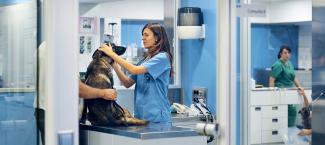Understanding the Climbing Cost of Veterinary Care
As a veterinarian, I always celebrated the idea of pet insurance. I liked the options it gave my clients for financing their veterinary bills. I also liked that my insured clients seemed to be able to do more for their sick pets. But when it came to my own pets, I always thought I could go it alone. Working in an animal hospital, I could usually get medications and other supplies at a discount and perform much of the labour myself. But as my dogs aged and I left clinical practice, the tide started to shift. One of my dogs needed a root canal, and later an MRI: both performed by specialists. My other dog developed heart disease and needed prescription medications in her final four years…to the tune of about $200 a month! When it came time to welcome a new dog into the family, I knew I could no longer afford to “wing it” with my pets’ medical expenses. For me, insurance was a way to make sure I could navigate my new pup’s medical bills without sweating over the budget.
Many pet owners remember a time when most trips to the vet would cost fifty, a hundred, two hundred dollars. Perhaps a serious illness or emergency would amount to five or six hundred dollars. It was an expense, for sure, but something many families could handle. Today, it’s not unusual to see veterinary bills in the thousands for an illness or injury. But why the change? Why, in a single generation, have veterinary expenses become so costly that even veterinarians need to consider pet insurance? Inflation and advances in medical technology are often cited as factors for the swelling of veterinary fees; but that’s not the whole story. Let’s examine some other changes in the past three decades that have revolutionized veterinary medicine…and the fees we pay.
Quality and Safety Standards
When I entered the profession, it was still common to re-use items like needles, scalpel blades, and single-use drug vials. Patient monitoring during anesthesia was minimal. Sick animals were still “hospitalized” in unstaffed clinics overnight. Single-paragraph medical records were still considered acceptable. This approach to medicine, once typical, is considered negligent by today’s standards. Veterinary care has moved toward the fail-safe, monitored, and meticulously recorded approach seen in human hospitals. And that’s a good thing!

Credentialed Staff
A generation ago, veterinary hospitals were staffed by one or two trained veterinarians, a receptionist, and lay assistants. Since then, the field of professional veterinary nursing has developed and matured. Licensed veterinary technicians and formally trained assistants care for hospitalized animals, support surgical procedures, perform laboratory functions, and educate pet owners, among many other things. They offer pets and their owners the peace of mind of knowing that their pet’s monitoring and care is being delivered by a knowledgeable and prepared team of individuals.
Availability of Specialty Care
Veterinarians are no longer just veterinarians. General practice vets have taken the relationship-centric role of the family practitioner. But increasingly, your family vet has the option to refer complex cases to board-certified specialists in veterinary internal medicine, surgery, oncology, dentistry, nutrition, and more! In many areas, unstable or serious cases can be transferred to a 24-hour facility for attentive or intensive care. Just like humans, pets benefit most when they can be cared for at a level that their condition demands, by an expert in their exact illness. Specialty care has offered vast improvements in safety, treatment options, and patient outcomes.

Alternative and Complimentary Medicine
Alternative therapies like traditional Chinese medicine, acupuncture, massage, and chiropractic care have enjoyed extreme popularity among human patients. Naturally, many pet owners want to offer their animal companions the same comforts. The practice of veterinary alternative medicine has grown considerably in the past two decades, giving pet owners more treatment options than ever.
The Human-Animal Bond
Pet owners are more bonded, and more committed to their pets than ever before. They don’t just want health care for their animals, they want excellent health care. In the past, a serious trauma, like getting hit by a car, meant tragedy for many pets. Families today want their pets to get the care that can help them overcome a health crisis. They want access the advanced diagnostics and intensive care that have the power to save a life. The internet has brought a wealth of medical information to the fingertips of people everywhere. Not only are pet families closer than ever to their animals, they’re also well-informed about the techniques and technologies employed in human health. They are demanding the same care for their pets. From preventative medicine and nutrition, to intensive illness care, geriatric medicine, and dignified end-of-life services, we all want the best for the four-legged members of our families.
Delivering safe, high-quality, and cutting-edge medical care to our pets is costly. But at the end of the day, it’s what I wanted to be able to do for my dogs, no matter what came up. And many people see it the same way. But for my family, paying out-of-pocket was not an option. As a vet, I know that there’s a good chance my new pet will need advanced or chronic care at some point in the future…and I know how expensive it can get. So, for me, pet insurance was an essential part of pet adoption…just as vital as choosing a food or committing to those daily walks.
